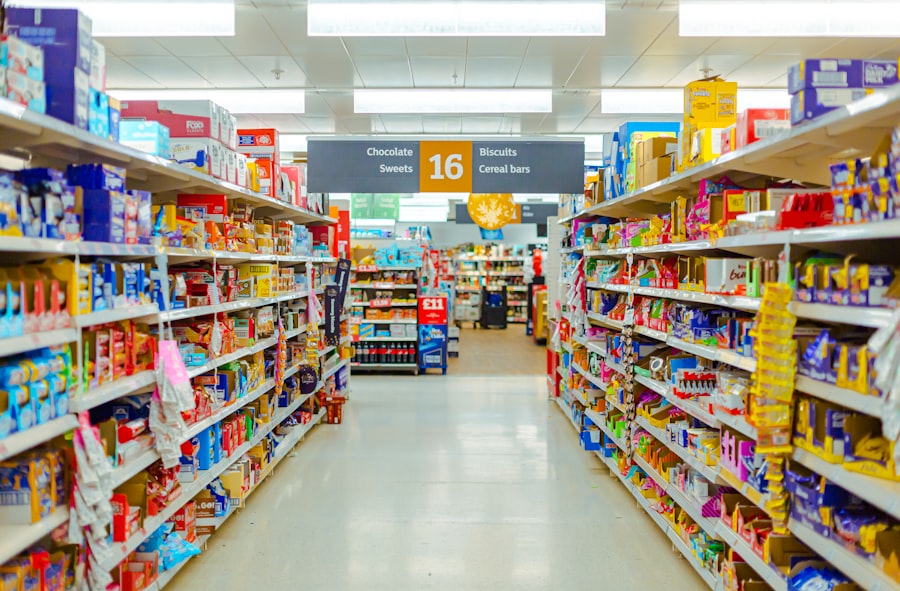Grocery shopping has undergone a remarkable transformation over the years, evolving from a simple, local experience to a complex, technology-driven process. In the early days, you would visit a neighborhood market, where fresh produce and staple goods were sold by local vendors. The interaction was personal, and you could often engage in conversations with shopkeepers who knew your name and preferences.
This community-centric approach fostered a sense of belonging and trust, making grocery shopping a social activity as much as a necessity. As urbanization increased and lifestyles changed, so did the grocery shopping experience. The rise of supermarkets in the mid-20th century introduced a new level of convenience, offering a one-stop-shop for all your needs.
You could find everything from fresh fruits to household items under one roof, often at lower prices due to economies of scale. This shift not only changed how you shopped but also how you perceived value. The introduction of self-service models allowed you to browse aisles at your leisure, but it also meant that the personal touch of local markets began to fade away.
Today, with the advent of online shopping and delivery services, grocery shopping has reached yet another level of convenience, allowing you to order your groceries from the comfort of your home.
Key Takeaways
- Grocery shopping has evolved from traditional brick-and-mortar stores to online platforms and mobile apps, offering convenience and flexibility to consumers.
- Dynamic pricing is the practice of adjusting prices in real-time based on various factors such as demand, competition, and consumer behavior.
- Dynamic pricing is revolutionizing grocery shopping by allowing retailers to optimize pricing strategies, increase revenue, and offer personalized discounts to consumers.
- Consumers benefit from dynamic pricing through potential cost savings, personalized offers, and the ability to make informed purchasing decisions.
- Challenges and concerns with dynamic pricing include potential price discrimination, lack of transparency, and consumer trust issues, impacting traditional grocery stores and their pricing strategies.
Understanding Dynamic Pricing
Dynamic pricing is a pricing strategy that allows retailers to adjust prices in real-time based on various factors such as demand, competition, and consumer behavior. This approach is not new; it has been widely used in industries like airlines and hospitality for years. However, its application in grocery shopping is relatively recent and is gaining traction as technology advances.
You may have noticed that prices for certain items fluctuate frequently, sometimes even within the same day. This is a direct result of dynamic pricing strategies being employed by grocery retailers. The mechanics behind dynamic pricing involve sophisticated algorithms that analyze vast amounts of data to determine optimal pricing.
These algorithms take into account factors such as inventory levels, competitor pricing, time of day, and even weather conditions. For instance, if there’s an unexpected surge in demand for avocados due to a trending recipe on social media, the price may increase accordingly. Conversely, if a store has an excess supply of a particular item nearing its expiration date, you might see a discount to encourage quick sales.
Understanding this concept is crucial for you as a consumer, as it can significantly impact your shopping experience and budget.
How Dynamic Pricing is Revolutionizing Grocery Shopping

Dynamic pricing is revolutionizing grocery shopping by introducing a level of flexibility and responsiveness that was previously unattainable. As you navigate through your local grocery store or online platform, you may find that prices are no longer static but rather fluid, adapting to market conditions in real-time. This shift allows retailers to optimize their sales strategies and manage inventory more effectively.
For you, this means that the price you pay for groceries can vary significantly based on when and how you shop. Moreover, dynamic pricing encourages competition among retailers. If one store raises its prices on certain items, others may lower theirs to attract price-sensitive customers like yourself.
This competitive landscape can lead to better deals and promotions, ultimately benefiting you as a shopper. However, it also means that you need to be more vigilant about price changes and be prepared to adjust your shopping habits accordingly. The ability to compare prices across different platforms has never been easier, thanks to technology, making it essential for you to stay informed about the best deals available.
Benefits of Dynamic Pricing for Consumers
| Benefits of Dynamic Pricing for Consumers |
|---|
| 1. Personalized pricing based on demand and supply |
| 2. Potential for lower prices during off-peak times |
| 3. Ability to take advantage of discounts and promotions |
| 4. Increased transparency in pricing strategies |
| 5. Opportunity for price matching and competitive pricing |
Dynamic pricing offers several benefits for consumers that can enhance your grocery shopping experience. One of the most significant advantages is the potential for lower prices on items that are in high supply or nearing expiration. Retailers often use dynamic pricing to clear out inventory quickly, which can lead to substantial savings for you.
If you’re willing to be flexible with your shopping habits and timing, you can take advantage of these discounts and stock up on essentials without breaking the bank. Additionally, dynamic pricing can lead to more personalized shopping experiences. As retailers gather data on your purchasing habits and preferences, they can tailor promotions and discounts specifically for you.
Such personalization not only enhances your shopping experience but also fosters brand loyalty as you feel more valued as a customer.
Challenges and Concerns with Dynamic Pricing
While dynamic pricing presents numerous benefits, it also raises several challenges and concerns that consumers should be aware of. One major issue is the potential for price discrimination. As retailers collect data on your shopping behavior, they may adjust prices based on your perceived willingness to pay.
This could mean that two customers standing next to each other in the same store might pay different prices for the same item based solely on their shopping history or demographic information. This practice can lead to feelings of unfairness and mistrust among consumers. Another concern is the complexity of navigating fluctuating prices.
With dynamic pricing in play, it can be challenging for you to determine whether you’re getting a good deal or being overcharged. The constant changes can create confusion and frustration, especially if you’re not equipped with the tools or knowledge to track price variations effectively. As a consumer, it’s essential to stay informed about pricing trends and be proactive in seeking out the best deals to mitigate these challenges.
How Dynamic Pricing is Impacting Traditional Grocery Stores

Dynamic pricing is significantly impacting traditional grocery stores by forcing them to adapt their business models in response to changing consumer expectations and competitive pressures. Many brick-and-mortar stores are now implementing technology-driven solutions to monitor prices in real-time and adjust them accordingly. This shift requires investment in new systems and training for staff, which can be challenging for smaller retailers with limited resources.
Moreover, traditional grocery stores are facing increased competition from online retailers that have fully embraced dynamic pricing strategies. As more consumers turn to e-commerce for their grocery needs, brick-and-mortar stores must find ways to differentiate themselves while remaining competitive on price. This may involve enhancing the in-store experience through personalized service or unique product offerings that cannot be replicated online.
For you as a consumer, this means that traditional grocery stores may become more innovative in their approach to attract and retain customers.
The Role of Technology in Dynamic Pricing
Technology plays a pivotal role in the implementation of dynamic pricing strategies within the grocery sector. Advanced algorithms and machine learning models enable retailers to analyze vast amounts of data quickly and accurately. These technologies allow grocery stores to monitor market trends, consumer behavior, and competitor pricing in real-time, facilitating timely adjustments to their pricing strategies.
Additionally, mobile apps and online platforms have made it easier for consumers like you to access information about price changes instantly. Many grocery retailers now offer apps that notify you of discounts or promotions based on your shopping history or preferences. This technological integration not only enhances your shopping experience but also empowers you to make informed decisions about when and where to shop for groceries.
Consumer Behavior and Dynamic Pricing
Consumer behavior is significantly influenced by dynamic pricing strategies employed by grocery retailers. As prices fluctuate based on demand and supply conditions, your purchasing decisions may become more strategic. You might find yourself waiting for discounts or promotions before making a purchase rather than buying items at their regular prices.
This shift in behavior can lead to changes in shopping patterns, such as bulk buying during sales or opting for generic brands when prices rise. Moreover, the psychological aspect of pricing cannot be overlooked. When faced with dynamic pricing, you may experience a sense of urgency or fear of missing out (FOMO) when prices drop temporarily.
Retailers often leverage this psychological trigger by promoting limited-time offers or flash sales that encourage quick decision-making on your part. Understanding these behavioral patterns can help you navigate the complexities of dynamic pricing more effectively.
The Future of Grocery Shopping with Dynamic Pricing
The future of grocery shopping is poised for further evolution as dynamic pricing becomes increasingly prevalent. As technology continues to advance, we can expect even more sophisticated algorithms that will refine how prices are determined and adjusted in real-time. This could lead to an even more personalized shopping experience where prices are tailored not just based on historical data but also on predictive analytics that anticipate your needs.
Additionally, as consumers become more accustomed to dynamic pricing models, there may be a shift in expectations regarding transparency and fairness in pricing practices. Retailers will need to strike a balance between leveraging data for competitive advantage while ensuring that consumers feel valued and treated fairly.
Tips for Consumers to Navigate Dynamic Pricing
Navigating dynamic pricing can be challenging but not impossible with the right strategies in place. One effective tip is to stay informed about price trends for items you frequently purchase. By tracking prices over time—whether through apps or personal notes—you can identify patterns that will help you determine the best times to buy.
Another useful strategy is to sign up for loyalty programs or newsletters from your favorite grocery stores. These programs often provide exclusive discounts or early notifications about sales events tailored specifically for you. Additionally, consider using price comparison tools available online or through mobile apps that allow you to check prices across different retailers before making a purchase decision.
The Ethical and Regulatory Considerations of Dynamic Pricing in Grocery Shopping
As dynamic pricing becomes more widespread in grocery shopping, ethical considerations come into play regarding fairness and transparency in pricing practices. Consumers may feel uneasy about being charged different prices based on their purchasing history or perceived willingness to pay. Retailers must navigate these ethical dilemmas carefully to maintain trust with their customer base.
Regulatory bodies may also step in to establish guidelines around dynamic pricing practices to ensure consumer protection against potential exploitation or discrimination based on personal data usage. As a consumer, being aware of these ethical implications can empower you to advocate for fair practices within the grocery industry while making informed choices about where and how you shop. In conclusion, dynamic pricing is reshaping the landscape of grocery shopping in profound ways.
While it offers numerous benefits such as personalized experiences and potential savings, it also presents challenges that require vigilance from consumers like yourself. By understanding how dynamic pricing works and employing strategies to navigate its complexities, you can make informed decisions that enhance your grocery shopping experience while advocating for fairness within the industry.
Dynamic pricing in grocery stores is an innovative approach that allows retailers to adjust prices in real-time based on various factors such as demand, competition, and inventory levels. This strategy can lead to more efficient inventory management and potentially lower prices for consumers during off-peak times. An interesting article that delves into the broader implications of dynamic pricing and its impact on consumer behavior can be found on How Wealth Grows. For more insights, you can read the article by visiting How Wealth Grows.
WATCH NOW! How Algorithms Quietly Bloat Your Grocery Bill; Here’s How to Fight Back
FAQs
What is dynamic pricing in grocery stores?
Dynamic pricing in grocery stores refers to the practice of adjusting the prices of products in real-time based on various factors such as demand, supply, time of day, and even the individual shopper’s purchasing history.
How does dynamic pricing work in grocery stores?
Dynamic pricing in grocery stores typically involves the use of algorithms and data analysis to determine the optimal price for each product at any given time. Prices can be adjusted both online and in physical stores to maximize profits and sales.
What factors can influence dynamic pricing in grocery stores?
Factors that can influence dynamic pricing in grocery stores include demand for certain products, inventory levels, competitor pricing, time of day, seasonality, and even the individual shopper’s behavior and purchasing history.
Is dynamic pricing common in grocery stores?
Dynamic pricing is becoming increasingly common in grocery stores, especially with the rise of online shopping and the availability of data analytics tools. Many grocery chains are experimenting with dynamic pricing to stay competitive and maximize profits.
What are the potential benefits of dynamic pricing for grocery stores?
Some potential benefits of dynamic pricing for grocery stores include the ability to optimize pricing for maximum profitability, reduce waste by selling perishable items before they expire, and offer personalized pricing and promotions to individual shoppers.
Are there any potential drawbacks or concerns with dynamic pricing in grocery stores?
Some concerns with dynamic pricing in grocery stores include the potential for price discrimination, consumer backlash if prices fluctuate too frequently, and the need for transparency to ensure trust and fairness for shoppers.
